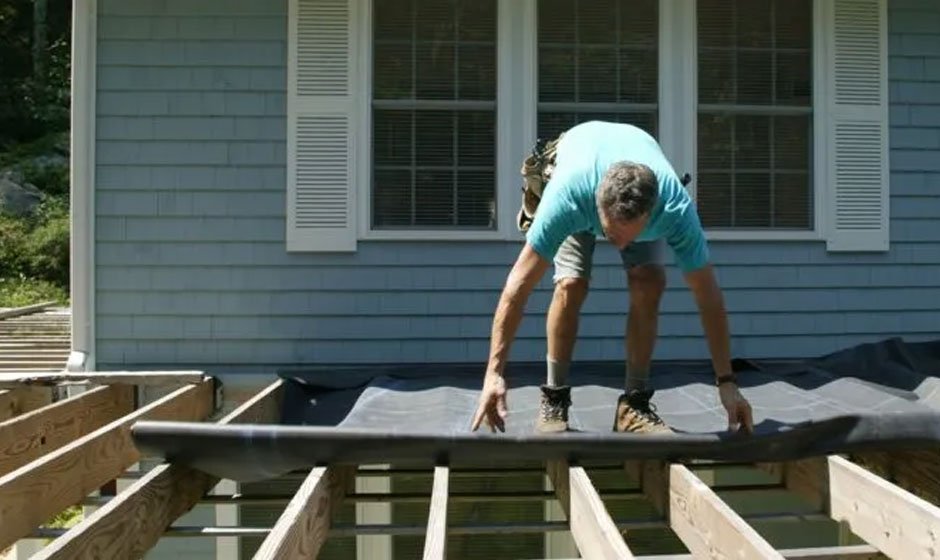An under-deck space can be a valuable addition to your home, supplying extra usable space for various activities. Whether you’re planning to create an outdoor living area or a storage space or want to protect the area below from water damage, deciding the right waterproofing system is paramount. With many options available, selecting the best waterproofing system for under a deck mandates careful consideration of factors such as durability, installation ease, maintenance requirements, and budget. We will explore the diverse waterproofing methods and their pros and cons to help you make a knowledgeable decision.
1. Under-Deck Ceiling Systems:
Under-deck ceiling systems are designed to create a watertight barrier between the deck boards above and the space below. These systems often consist of interlocking panels or sheets installed beneath the deck joists, effectively diverting water from the area below. Under-deck ceiling systems deliver a finished look to the underside of the deck while preventing water from seeping through.
Pros:
- Creates a finished ceiling appearance.
- Effectively channels water away from the deck’s underside.
- Reduces the risk of water damage to the space below.
Cons:
- Installation can be more complex and might require professional help.
- Limited design options compared to open or partially open systems.
2. Deck Membranes:
Deck membranes are waterproof materials that are applied over the deck structure before installing the deck boards. These membranes construct a continuous barrier that prevents water from parting through the deck surface. They arrive in diverse forms, including peel-and-stick membranes and liquid-applied coatings.
Pros:
- Delivers a seamless waterproof barrier.
- Can be applied to diverse types of decks, including wood and concrete.
- Offers flexibility in design and finish.
Cons:
- Proper installation is paramount to ensure effectiveness.
- Some types of deck membranes might mandate regular maintenance or reapplication.
3. Waterproof Deck Tiles:
Waterproof deck tiles are individual tiles or panels designed to snap together, creating a waterproof surface for the deck. These tiles generally have built-in drainage systems that direct water away from the space below. They are a versatile option that integrates aesthetics with functionality.
Pros:
- Easily replaceable in case of damage.
- Allows for creative design patterns and customization.
- Delivers effective drainage and protection against water infiltration.
Cons:
- Installation can be time-consuming, especially for large areas.
- Some designs might not deliver a completely finished look.
4. Under-Deck Drainage Systems:
Under-deck drainage systems consist of a series of troughs and gutters that are installed beneath the deck structure. These systems collect rainwater that falls through the deck boards and direct it away from the space below. Under-deck drainage systems are often combined with waterproof ceiling options for comprehensive protection.
Pros:
- Provides a comprehensive water management solution.
- Compatible with various deck types and designs.
- Can be customized to fit the specific layout of your deck.
Cons:
- Installation might be more involved due to the drainage infrastructure.
- Maintenance is necessary to ensure proper function and prevent clogs.
5. Waterproof Canvas or Fabric:
Waterproof canvas or fabric systems involve installing tensioned fabric panels beneath the deck joists. These panels protect against rain and water infiltration while enabling airflow. This option is appropriate for those seeking a more temporary or cost-effective solution.
Pros:
- Relatively cost-effective approximated to some other options.
- Protects water without a fully enclosed appearance.
- Proposes an easy installation process.
Cons:
- It might not offer the same level of protection as more robust systems.
- Durability and longevity could be compromised over time.
Factors to Consider:
● Climate and Weather Conditions:
The type of waterproofing system you choose should suit your local climate and weather patterns well. Consider factors such as heavy rainfall, snow accumulation, and temperature fluctuations.
● Deck Material:
Different waterproofing systems might be more compatible with certain deck materials. Ensure that the chosen system is appropriate for your deck’s construction.
● Usability of Space:
Consider how you plan to use the space below the deck. Some systems might be more suitable for creating an outdoor living area, while others are better for storage.
● Budget:
The cost of installation and materials can vary significantly depending on the chosen system. Set a budget and explore options that align with your financial considerations.
● Maintenance:
Consider the maintenance requirements of the chosen system. Some systems might need periodic inspections, cleaning, or reapplication of coatings.
● Aesthetics:
Depending on your preferences, you might prioritize a finished ceiling appearance, a seamless surface, or a more open design. Choose a system that aligns with your aesthetic vision.
Selecting the best waterproofing system for under a deck is a decision that involves careful assessment of your needs, budget, and preferences. Each type of system comes with its own set of benefits and considerations. Whether you opt for under-deck ceiling systems, deck membranes, waterproof tiles, drainage systems, or fabric options, the goal is to ensure the space beneath your deck remains dry, functional, and protected from water damage.
Consulting with professionals and conducting thorough research will help you make an informed choice that enhances the value and utility of your outdoor living space—Are you searching for deck waterproofing contractors in Los Angeles? Look no further for professional, reliable services to protect your outdoor living space.

